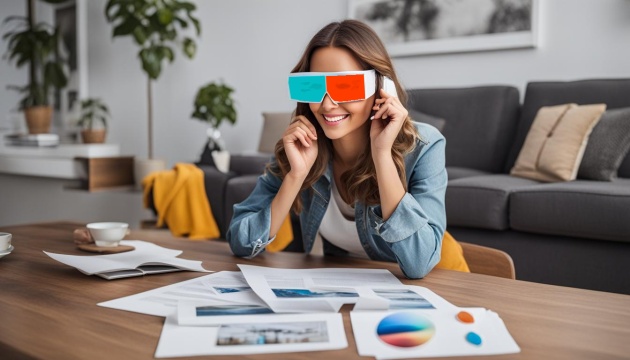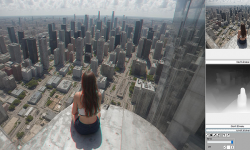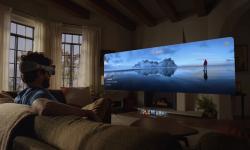What the eyes see
The creation of stereographic (3D) images is based on what our eyes actually see when an object is closer or farther away. Rather than go into a long discussion of this, let's simply try it out for ourselves. All you need to do this is any object you can pick up, such as an ordinary pencil.
So: take a pencil vertically (e.g. with the tip up) in your hand. Put it in front of your eyes at a distance where you can see it clearly. Now look at an object behind the pencil - for example, the coffee cup on your desk, the computer monitor, or the alarm clock on your bedside table. The pencil should be some distance away from this object - at least 15 centimetres.
The left eye sees things that are in front, a little more to the right than the right eye.
Close your left eye and move the pencil so that you can easily remember its exact position. For example, it may be exactly covering the eyelet of a cup, the left edge of a monitor, or the right edge of an alarm clock. Now swap open eyes - open the left one and close the right one. If you did the whole experiment carefully, the pencil will appear to have moved to the right (when in fact it hasn't moved at all). Failed? Try again.
From the above experiment, it can be seen that the left eye sees things that are in front (e.g. in front of the edge of the monitor) a little more to the right than the right eye. Objects at the back are more to the left (you can try this by putting a pencil behind the edge of the monitor this time, for example.) How can this be used to get a spatial image, such as a photograph? Just have one photo taken as the left eye sees it, and another as the right eye sees it. Then you just need to merge the two photos so that when you look at them, each eye sees only its part. Since normally both eyes will see the same thing in the merged photo, special glasses are needed.
Red and blue glasses
The most affordable glasses that allow you to see stereograms are the red and blue (or cyan) glass (mica) glasses. Even though these are relatively inexpensive devices, there is one problem: You can't usually buy them at the corner store. However, in e-shops you should succed. Perhaps on one of the Asian marketplaces, such as Aliexpress.
And how do the glasses work? If you put them properly in front of your eyes (red glass in front of the left and blue (cyan) glass in front of the right), you can find out two things - first, that the left one now sees the world in red and the right one in blue. However, a careful observer will discover one more important thing: If an object is red (e.g., a red mug on a white table), the left eye almost doesn't see it (it sees the table and the mug as red), while the right eye sees it as dark. Similarly, the right eye does not see blue (or blue-green) and the left eye does. When the background is other than white, the situation changes somewhat - but each eye still sees something different.
And that's the trick. So just keep only the colours that each eye can see from the original photos for the left and right eye, and then merge the two photos together. Then put on the glasses and you can enjoy the spatial image. But how do you omit the colours and merge the images?
Suitable software
In order to create a stereogram from the left and right photos, you should use a suitable software (computer program). 3DJournal.com has created such a program and it is available on our website.
We have created the program so that it easily allows you to create stereographic (3D) images even from photos taken with ordinary cameras. Thus, you can easily move the left and right photos relative to each other as well as rotate them to get the best results. You can also create a black and white image and save both the entire image and a crop of the image. Processing multiple images simultaneously is also supported - so you can easily create 3D movies.
And one more note
Images that use red-blue glasses to display in space are called anaglyphs. There are other possibilities - using the polarizing effect, quickly covering and uncovering the eyes with an LCD, and more. However, apart from anaglyphs, none of the 3D images can yet be easily and cheaply created and viewed at home.
3DJournal, July 2003





